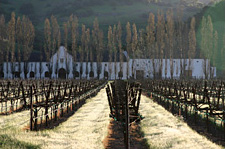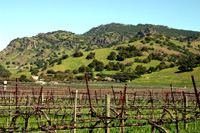
Chimney Rock Winery
by Eric Anderson
(excerpted from Vol.12 No.1, Journal du Vin, March 2004. …a visit on 3/12/04 to Chimney Rock Winery for a tour and tasting.)
 |
I had been in contact with Pete Danko, public relations manager for the Terlato Wine Group, to arrange a visit with winemaker Doug Fletcher of Chimney Rock Winery. Fortunately, Pete found a time during Doug's very busy schedule for us to get together. The time spent with Doug proved to be very illuminating, and caused me think about winegrowing differently.
Chimney Rock started life as a 185-acre golf course. Founded in 1980, the new owners purchased the golf course and planted 75 acres of grapes - both red and white, producing the first vintagein 1984. Current winemaker, Doug Fletcher, was brought aboard in 1987, after having served stints at Steltzner and Martin Ray.
In the early 1990s, phylloxera decimated the original vineyards, requiring replanting - and rethinking exactly what varietals ought to be planted. Considering the the Stag's Leap reputation for red Bordeaux varietals, only Cabernet Sauvignon, Merlot, Cabernet Franc, and Petite Verdot were planted. By 1997, replanting was completed. In 2000, the Terlato Wine Group partnered with the original owners, and planted an additional 60 acres to Cabernet, bringing the total vineyard acreage to 119.
 |
|
the
Stag's Leap rock formation
|
Meanwhile, Doug Fletcher was suggesting that Chimney Rock actually look at winegrowing differently. Eschewing intervention in the winery as merely trying to fix a problem originally caused in the vineyard, Doug felt that both proper berry size and ripeness need to have been determined by verasion, or you're stuck trying to fix things retroactively in the winery. Doug looked at cell division versus cell enlargement within the fruit. He wanted to keep the cell division down in order to keep the berry size small, by encouraging the vine to stop growth early, and "set" the berry size.
Doug pointed out that his goal was to get the same crop - both weight and berry size - from each vine. This meant that he needed to "tune" not only each block, but also tune each row and each vine to its own particular need. To do this, he looked more closely at things like soil and canopy. In different soil conditions, the vine's need changes - requiring more or different spacing, and/or pruning to maintain the acceptable vine balance from row to row, and section to section. While soil, or terroir, is indeed important, Doug has found that it is not the be-all end-all of wine growing. Rather, from his observation (and tasting), it appears that achieving "vine balance" is actually the major factor in determining the final quality of a wine.
In seeking a balance in the grapes, Doug felt the ratio of fruit weight to leaf area should be constant. This meant re-examining canopy maintenance. Canopy leaves need to do two things well - convert water into sugar in the grapes, and shade the fruit from the damaging effects of the sun. How much canopy is ideal? From Doug's experience, only enough to provide shade for the fruit - or about one leaf per cluster. Too many leaves merely divert effort away from proper fruit ripening. This can get dicey, of course. Too little canopy for the fruit, is nearly as bad as too much. What was needed was a way to ideally expose all of the fruit equally.
 |
|
the
Fletcher Lyre trellis
|
Doug devised a trellising system that has become known as the Fletcher Lyre. He found that raising one side of the conventional lyre trellis to a level about one foot higher than the other created a more balanced sunlight exposure on the fruit. In Chimney Rock's case, this meant raising the north side of the trellis to get more sunlight exposure, and consequently a more balanced ripening process.
Interestingly, this "balance" effect has proliferated throughout the vineyard, resulting in a more consistent ripening of fruit. As testimony to this, the Reserve lots in fact do not necessarily come from specific blocks in the vineyards, but rather are made of from the more perfectly balanced fruit found in the vineyard - something that can change with each vintage.
As Doug Fletcher led us around from the vineyard through the cellars and finally to the tasting room, it struck me that despite his long experience at winegrowing, he still maintains a marvelous wonderment about it all. We're just beginning to figure things out, he said, obviously relishing each and every day he spends at his "work." And then it occured to me, that's what wine itself is all about - searching...learning...trying to figure things out - and all the while maintaining an awe for what we learn. Yes indeed, here was time well spent.
|
|
|
All rights reserved No original material may be reproduced without written consent Mail & Comments - Eric Anderson |
||

|
